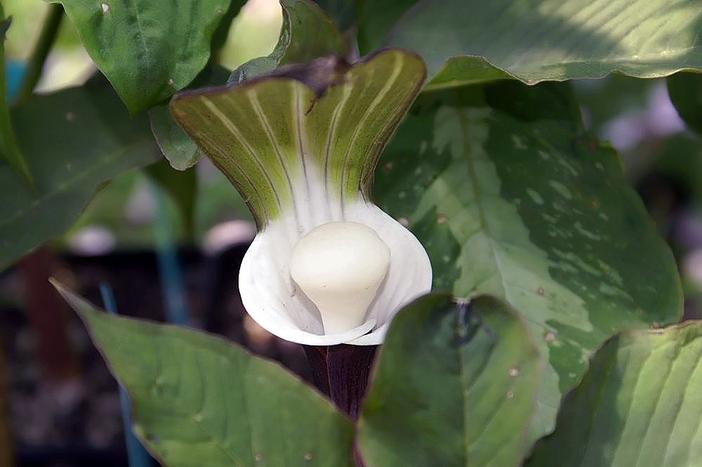Japanese Cobra Lily
(Arisaema sikokianum)
Japanese Cobra Lily (Arisaema sikokianum)
/
/

David J. Stang
CC BY-SA 4.0
Image By:
David J. Stang
Recorded By:
Copyright:
CC BY-SA 4.0
Copyright Notice:
Photo by: David J. Stang | License Type: CC BY-SA 4.0 | License URL: https://creativecommons.org/licenses/by-sa/4.0 | Uploader: David Stang | Publisher: Wikipedia Commons





















Estimated Native Range
Summary
Arisaema sikokianum, commonly known as Japanese Cobra Lily, is a deciduous perennial herb that is native to the understory of cool, moist forests in Japan. It typically grows to a height and width of approximately 2 feet (0.6 meters). The plant is known for its striking inflorescence, which consists of a large, hood-like spathe with purple, green, and white stripes, resembling a cobra about to strike. The spathe surrounds a central spadix, which is often a smoky-purple color with a snow-white cup. The flowers, which are not particularly showy, appear in the spring and are followed by a cluster of bright red berries in the fall.
Japanese Cobra Lily is valued for its unique and exotic appearance, making it a conversation piece in shade gardens. It is often used in combination with other shade-loving plants such as hostas and bleeding hearts. This species thrives in part shade to full shade and prefers consistently moist, well-drained soil rich in organic matter. It is relatively low maintenance but requires protection from strong winds and excessive sun. While not common, it can suffer from root rot if the soil is too wet. It is not known to be invasive and does not have aggressive roots, but it can be sensitive to overly dry conditions.CC BY-SA 4.0
Japanese Cobra Lily is valued for its unique and exotic appearance, making it a conversation piece in shade gardens. It is often used in combination with other shade-loving plants such as hostas and bleeding hearts. This species thrives in part shade to full shade and prefers consistently moist, well-drained soil rich in organic matter. It is relatively low maintenance but requires protection from strong winds and excessive sun. While not common, it can suffer from root rot if the soil is too wet. It is not known to be invasive and does not have aggressive roots, but it can be sensitive to overly dry conditions.CC BY-SA 4.0
Plant Description
- Plant Type: Herb
- Height: 1.5-2 feet
- Width: 1.5-2 feet
- Growth Rate: Slow
- Flower Color: Purple, White
- Flowering Season: Spring
- Leaf Retention: Deciduous
Growth Requirements
- Sun: Part Shade, Full Shade
- Water: Medium, High
- Drainage: Medium
Common Uses
Deer Resistant, Showy Flowers
Natural Habitat
Understory of cool, moist forests in Japan
Other Names
Common Names: Japanese Jack-In-The-Pulpit, Shikoku Cobra Lily
Scientific Names: , Arisaema sikokianum, Arisaema sikokianum var. serratum, Arisaema sazensoo var. serratodentatum, Arisaema magnificum, Arisaema sazensoo f. serratum, Arisaema sikokianum var. integrifolium, Arisaema sikokianum var. sikokianum, Arum sazensoo, Arum sazensoo publ,
GBIF Accepted Name: Arisaema sikokianum Franch. & Sav.